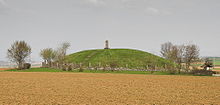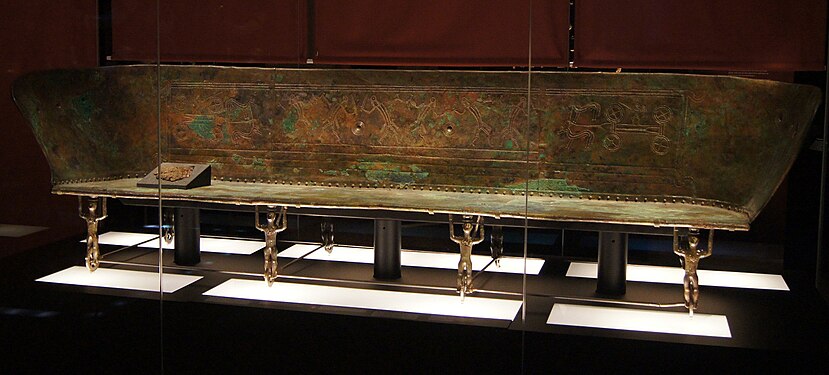Hochdorf Celtic Museum

The Hochdorf Celtic Museum is located in the Hochdorf district of Eberding , around 18 km west of Ludwigsburg in the Ludwigsburg district . It mainly shows replicas of the finds from the Celtic tumulus excavated in 1978 on the outskirts of the village and gives an overview of the way of life of the Celts in general.
Tumulus
On the outskirts there is a huge Celtic barrow ( 48 ° 53 ′ 20 ″ N , 9 ° 0 ′ 35 ″ E ), which was reconstructed after the excavations. With a height of around six meters and a diameter of 60 meters, it is one of the largest of its kind. Around 550 BC, a “prince” of the Hallstatt culture was buried here with great expense and rich grave goods. The location of the burial site was chosen with care: From the hill you have an unobstructed view of the Hohenasperg , the presumed princely seat , to the east .
The burial chamber has a size of 4.70 m × 4.70 m and was made of oak. This chamber was surrounded by another chamber and the whole thing was covered by a 50-ton stone packing to protect it from grave robbers.
The grave was protected from discovery and looters for so long because the burial mound was flattened to an imperceptible elevation. Stones that came to light when plowing were brought to the fore by a volunteer from the State Monuments Office.
museum
Elements of the burial mound were used to design the museum building. The metal arch at the front of the building represents the burial mound, the reconstructed burial chamber equipped with replicas is located under this arch in the same place as it was in the real grave. The replicas were made using Iron Age technology, the original finds are in the Württemberg State Museum in Stuttgart. The permanent exhibition also includes the Prince's original skeleton as well as documentary films about the find and the excavation.
Next to the museum building is a small open-air museum with reconstructions of various Celtic buildings, the remains of which were found in this very spot. Here are Hallstatt period craft techniques such. For example, iron extraction is shown using a racing furnace and a comprehensive overview of the intensive Iron Age settlement in the Ludwigsburg region, in which over 150 sites from this period were discovered.
In summer there is a regular program about the Iron Age in the open-air museum. There is a series of lectures organized by the Celtic Museum, and special exhibitions on similar finds or special topics such as B. Gold jewelry shown.
Grave finds
Since the grave had not been robbed before the excavation , particularly spectacular finds were made here.
Personal equipment of the dead
The dead man himself was richly furnished and decorated. He wore golden brooches , a gold bracelet, a belt, of which the golden belt plate is still present, as well as a splendid dagger and golden shoe trimmings. These additions were made especially for the funeral. The wide gold collar with rows of rider figures around it was worn during life. In addition, the deceased wore a conical hat made of birch bark. These additions, which can be regarded as status symbols, can also be found on the statue of the Warrior von Hirschlanden .
The other personal equipment of the deceased consists of two bronze clasps that held the grave cloths together, a finely sawn comb, a razor , an iron nail cutter, three fish hooks and a small iron knife. These additions were in a cloth bag with a bronze-studded leather clasp on the dead man's chest. The equipment was completed by five amber beads .
In the head area of the grave lord there was a bronze-covered quiver made from the root wood of the black poplar , in which there were 14 arrows, as well as a knife with a carved wooden sheath.
The bronze bench
The dead man was laid to rest on a bronze bench. This is decorated with punched scenes: in the middle of the backrest there are three pairs of swords fighting, on the sides four-wheeled chariots. These motifs are, however, alien to the Hallstatt culture. The closest stylistic comparisons to these motifs can be found in the situla art of northern Italy and the south-eastern Alps. Festive feasts, carriage rides, hunting or music and sports competitions are usually presented there.
The bench is 2.75 m long and is carried by eight female figures, each with a wheel between their legs.
The bench was upholstered with a bast pad and alternating badger skins, bast textiles, textiles made of roof wool, wool and linen fabrics.
The bronze bench shows signs of wear and an ancient image plane, which suggests that it already ended up in the grave as an old piece .
Bronze bench, original in the Württemberg State Museum
The float
At the time of the burial place, a float was a typical addition to the elite of that time. These were not used to transport loads, but were used in festive processions, perhaps also to transport the dead to the burial place. The car of the grave lord von Hochdorf is an almost completely preserved four-wheeled show car with accompanying bridle. The wheels, the drawbar and the outside are almost completely covered with sheet iron, the cladding consists of more than 1,300 individual parts, most of which are decorated with punch patterns. The car body is made of elm and ash wood and contained the harness for two horses, consisting of a double yoke made of maple wood, which was adorned with bronze-covered leather straps and facing bronze horses. Furthermore, it consists of the leather bridle , which was decorated with two decorative discs made of bronze, and the iron bridles. The harness also includes a wooden driving spike with a bronze handle and iron point with which the horses were driven.
The drinking and dining service
The dining service was also in the car body. It consists of three bronze basins with side handles and embossed edges as well as nine bronze plates. So it was meant for nine people. The dining service is a local work based on Etruscan- Italian models. As indicated by signs of wear and repairs, it was already in use during the lifetime of the tomb. The dinner service also includes multi-part slaughter and sacrificial cutlery.
The drinking service was also sufficient for nine people. This includes eight drinking horns that were hung on the southern wall of the chamber with the help of delicate bronze handles and wall hooks. The horns come from aurochs , the mouths were decorated with gold sheets. Above the dead man's head was the mighty ninth iron drinking horn, which was intended for the deceased himself. It has a capacity of 5.5 l and is decorated with little bull heads at the end.
The showpiece of the drinking service, however, is the large Greek bronze kettle. It stood in the northwest corner of the burial chamber at the feet of the deceased. The cauldron is made up of old parts and decorated with three lion figures on the edge. Two of these lions were born around 540 BC. Made in a Greek workshop, the third lion is a local production. It is masterfully executed, but visually reduced compared to the Greek lions. The bronze cauldron has a capacity of 500 l and was about three-quarters filled with freshly made mead at the burial place . During the excavation, there was a golden bowl and drinking bowl and a residue of mead in the cauldron .
The food and drink service marks Mr. von Hochdorf as the host of a feast.
Textile finds
Significant grave finds are also the particularly well-preserved textiles that were used as wall hangings, seat covers and as ceremonial cloths that were wrapped around the dead body and the bronze cauldron. This ensemble is unique for the Iron Age in Central Europe. Most textiles were woven from sheep's wool , but hemp and linen were also used. The weaves range from simple linen weave through to complex twill weave . The textiles were decorated with intricately woven rhombuses and patterns, and mostly with board-woven braids. Most of the textiles were blue and yellow, but there were also valuable textiles dyed red with the Kermeslaus dye imported from the Mediterranean .
Side graves and subsequent burials
In the burial mound there were two side graves that were created during the filling of the mound, as well as a subsequent burial on the edge of the mound, which is significantly younger than the central grave . The first side grave was located southwest of the central grave. A man was buried in it who had received fibulae of the same type as those in the main grave. The second side grave was under the stone circle of the hill. It consists of a stone-enclosed chamber in which a man was buried with bronze jewelry. This side grave also contained a clay pot with the ashes of another male dead.
literature
- Jörg Biel : The early Celtic princely grave of Eberdingen-Hochdorf, Ludwigsburg district. In: Denkmalpflege in Baden-Württemberg - Nachrichtenblatt der Landesdenkmalpflege , 7th year 1978, issue 4, pp. 168–175 ( doi: 10.11588 / nbdpfbw.1978.4.14500 , accessed on December 5, 2016).
- Jörg Biel: The Celtic Prince of Hochdorf. 3rd ed. Theiss, Stuttgart 1995, ISBN 3-8062-1172-8 .
- Jörg Biel: The Iron Age settlement in the Reps corridor and other prehistoric sites of Eberdingen-Hochdorf (Ludwigsburg district); with contributions by Carmen Adusumalli and Petra Edtbauer. State Office for Monument Preservation in the Stuttgart Regional Council, Theiss, Darmstadt 2015, ISBN 978-3-8062-3268-4 .
- Thimo Jacob Brestel: Influential beyond death. 40 years of research on the “princely grave” of Eberdingen-Hochdorf . In: Preservation of monuments in Baden-Württemberg 2/2019, pp. 112–116.
- Leif Hansen: Hochdorf VIII. The gold finds and costume additions from the late Hallstatt dynasty of Eberdingen-Hochdorf (district of Ludwigsburg). Research and reports on prehistory and early history in Baden-Württemberg 118. Theiss, Stuttgart 2010, ISBN 978-3-8062-2395-8 .
- Thomas Hoppe: True Treasures - Celts: State graves and centers of power from the 7th to 5th centuries BC in Württemberg. Exhibition catalog of the Landesmuseum Württemberg, Jan Thorbecke Verlag, Stuttgart, June 3, 2016, pp. 36–41.
- Antje Theel: The reconstruction of social structures using the example of the so-called princely grave of Hochdorf. University of Leipzig, Leipzig 2006 ( PDF ; 221 kB, accessed on December 5, 2016).
Web links
Individual evidence
- ↑ a b c Thomas Hoppe: True treasures - Celts: State graves and centers of power from the 7th to 5th centuries BC in Württemberg . Jan Thorbecke Verlag, Ulm 2016, ISBN 978-3-7995-1141-4 , p. 36-41 .
- ↑ According to information from Dr. Simone Stork from the Celtic Museum
Coordinates: 48 ° 53 '21.1 " N , 9 ° 0' 12.4" E





